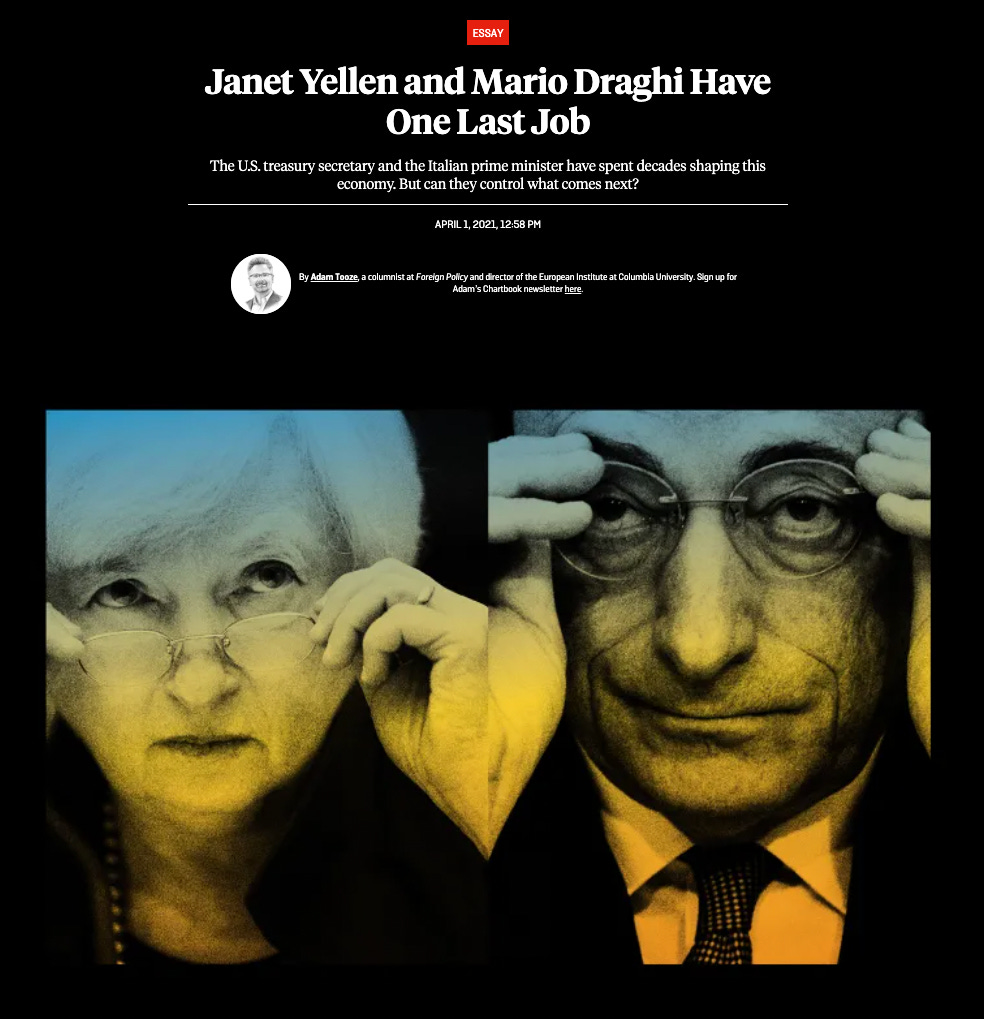In the last month I pulled myself together and wrote a long synthetic piece on the Biden administration for LRB .
Whatever happens in the election, Bidenism is over. The project anchored on the long-serving senator from Delaware and Obama’s vice president had one term in it. We are left asking how this four-year period fits into recent American history and what legacy it leaves.
If the LRB did illustrations, I would have pushed for it to have been adorned by the cover of the National Defense Industrial Strategy, which I start by describing. One smart friend suggested to me that the image was likely AI-generated.
The more I thought about the last four years, the more I felt that dark pastiche or dark camp were the appropriate stylistic genres in which to capture the administration. An early draft of the piece started with the delirious story of the “Dark Brandon” meme, which is truly worthy of Pynchon. In the end I opted for something softer, more washed out - Warhol meets Polo Ralph Lauren.
The image I had in mind was Warhol’s Elvis.
Imagine this with a dapper-looking Biden superimposed, something that AI could surely do for us.
Anyway, if I managed a halfway balanced assessment in the LRB piece, it is in large part due to wiser friends, notably Ted Fertik with whom I have been thinking about US political economy for many years.
Reflecting on the end of the administration I realized that this is the first in which I have been fully engaged in commentary on a daily basis from start to finish. It seemed like an occasion to pull together a selection of that writing. Again, this was not my own ideas but Grey Anderson’s at Verso.
Apart from the stuff from the Biden era proper, two earlier pieces seem particularly relevant for framing what follows.
From my personal website, where I started blogging in 2017, there is a post I did in December 2017 reflecting on the importance of Trump’s National Security Strategy 2017. I read that momentous document in a hotel room in Miami. I still remember my shock at realizing the fundamental shift in US strategic posture against China that it announced.
Then there is the LRB lecture that appeared in the spring of 2019 as: “Is this the end of the American century?”
Things kicked into a higher gear in 2020 with a flow of pieces out of which came Shutdown. That global overview of the COVID shock ends with the inauguration. But in The Guardian, New Statesman, Foreign Policy, the Financial Times and on Chartbook I continued to track the Biden administration.
I have organized the pieces here chronologically with notes for context. The pieces I have selected are limited to those that offer some general assessment of the Biden administration.
On November 1 2020, ahead of the election, I vented some stress with “Making American normal again”, for the Guardian.
Again in Guardian on Nov 5 2020 I was worrying about the obstacles that a Biden Presidency would face.
On November 11 2020 in Foreign Policy I attempted to sketch an outline of Biden’s economic policy team. What was on my mind, echoing what we know about what was going on in the Obama camp in the last months of 2008, was the question of whether the powerful gatekeepers of 1990s economic policy would assert themselves.
I explored that question further in a piece I did for the LRB in April 2021 on Paul Krugman and the gatekeepers of neoliberalism.
In “America’s Race to Net Zero” - a longer piece from April 2021 in the New Statesman -I took an early sounding on Biden’s emerging climate agenda.
The companion piece to the climate policy discussion was Chartbook #19, (2021 May 8) in which I assessed the scale and significance of “American Family Values and Biden's Families Plan”.
By June 19, I was beginning to worry not just about the domestic policy agenda but also about the anti-China twist of Biden’s policy program and in Chartbook #23 I compiled a detailed chronological account of Biden's China strategy and some of the personnel involved.
I was primed for the twist from domestic radicalism to foreign policy aggression amongst other things by thinking about Paul Krugman’s trajectory during the 2008-9 crisis.
Later that summer (August 12) in the Guardian, what was troubling me was the Biden team’s effort to accelerate oil production, all the while proclaiming a climate administration.
I expanded on that same theme on Aug 14 in Chartbook #32 on Biden's foreign policy for the middle class, climate and OPEC... deciphering cognitive dissonance
Then came the Afghanistan withdrawal (completed Aug 30 2021) and it was all hands on deck to counteract stupid narratives about the retreat of American power. A long piece in the New Statesman on the “New Age of the American Power”, kicked up some dust.
By September 2021 we were already beginning to worry about legislative impasse and Joe Manchin. This would become a troublesome theme for commentators for the next 12 months. The Democratic majority was wafer thin and that gave veto players huge sway.
On September 19 Chartbook #41 I addressed “The interlocking crises that will shape the future of Biden Presidency: Infrastructure bill, reconciliation bill, debt ceiling”. A month later, it seemed necessary in Chartbook #46 to address the question of “West Virginia - the historic roadblock to US climate policy: Making sense of Manchin”
By December 2021 I was in a downbeat mood. In the New Statesman I did a piece on the agonizing struggles over Build Back Better and the President’s climate agenda under the title, “The stalled Presidency”.
On Dec 19 still on the Build Back Better tip, in Chartbook #61, I addressed what I still think is one of the most interesting aspects of the legislative history of the Biden administration, the “climate revolution in fiscal policy?: Making sense of Build Back Better”. The point here was that for the first time legislation was being modeled and benchmarked in real time according to emissions models. What I had in mind in calling it a “climate revolution” was the much-dated Keynesian revolution in government in the 1930s and 1940s, when fiscal policy began, for the first time, to be understood in macroeconomic terms.
In January 2022 I did a survey for the Guardian on Biden’s first year and the sense that his Presidency seemed stuck in an impasse.
Then came the Russian invasion of Ukraine and questions of foreign policy became more important than ever. I wrote a lot about that under a different rubric. Some of that is focused on the US but much of it is quite technical. In May 2022 in the Guardian, under the sign of escalatory fear, I was worrying about the Lend-Lease program for Ukraine and marveling over the elephantine historical memory of America’s gerontocracy.
Then, in July 2022 I got it wrong.
Along with a lot of other people I became convinced that the Biden administration had run out of time and Manchin had killed the reform agenda. It was a moment of despair and the best thing seemed to be to shout about it as loudly as possible. I did that in the New Statesman with a piece entitled “How Joe Biden Failed.” And I repeated the message in a piece in Chartbook on July 20 entitled “Build Back Better, Dead Again”. It turns out that we had underestimated the capriciousness and tactical nous of the Manchin-Schumer couple.
Quite suddenly, to the amazement of many of us, a deal was done on what would become known as the Inflation Reduction Act. I even found myself on the call list of Schumer’s people, who wanted to explain what they had done.
I tried to make sense of the episode in Chartbook #139 August 2, “The battle for climate legislation in the US: making sense of the Manchin-Schumer compromise”.
And then attention pivoted back to foreign policy with Pelosi’s provocative visit to Taiwan and the first phase of a real war scare with China: 2022 Aug 3 Chartbook #140: China-Taiwan-Pelosi special.
I would later look back on this episode as the beginning of a dramatic phase of escalation with China, which culminated in the spring of 2023 with a palpable state of alarm in Washington DC. “The "war in sight" scare of February 2023 & its aftermath - learning to manage the Sino-US confrontation” (Chartbook 249 October 26 2023).
Back to August 2022 and in Chartbook #141, I was asking: “Is financial uncoupling from China beginning?”
My worries about primacy as the fundamental basis of US policy was summed up in a review essay for New Statesman.
I ended the year worrying in Chartbook #182 (2022 Dec 23 ) about “Washington's disruptive new consensus”.
And that was massively reinforced by impressions from inside the Biden administration in the early months of 2023.
By April in Foreign Policy I was musing over Janet Yellen’s extraordinary speech on the Thucydides trap and how China and the US could avoid war so long as the US, under the wise stewardship of the Biden team, stayed strong and China avoided challenging in any areas that the US considered vital to its national security interest. Just so long … As the headline put it: America has dictated its economic peace terms to China.
I did a more extended commentary on Yellen in a double portrait of Yellen and Mario Draghi in Foreign Policy back in August 2021.
In July 2023 in Chartbook 225 I tracked her visit to China under the title “Not de-escalation, or economic peace, but managed tension”.
On May 5 2023 in the Financial Times I invoked Polanyi to argue that “Washington isn’t listening to business on China any more. The waning of the ‘peace interest’ leaves multibillion-dollar investments hanging by a thread”.
And then, as the Biden administration again clashed with Congress, I did a piece in the FT on “Why America’s economic policy muddle matters. The messy nature of decisions is important both for US citizens and the world”.
One area of cognitive dissonance that again and again catches the eye, are the stunted relations between the United States and its Southern neighbors. I addressed this in Chartbook for the first time on June 3 2023 with Chartbook 218: "So far from god" ... friend-shoring and the debate in Washington over whether to bomb Mexico.” And yes, if you are wondering, there really is such a “debate” in Washington.
I returned to the theme a year later on August 8 2024 in the FT. “Kamala Harris must face America’s nimbyism head on”. And on August 9 Chartbook 307 “To live or not live with polycrisis: the USA, Mexico and the need for a regional policy in Central America”.
One year on from the agreement on the Inflation Reduction Act a bunch of folks online were discussing the significance of Bidenomics and industrial policy.
I got into this in Chartbook 220 (2023 June 14) Biden's "new industrial policy": Revolution in the making, or an exercise in defying gravity?
And on June 17 in Chartbook 221 on “The IRA (& the Fed) debate - bringing hegemony back in”.
All the talk of (civilian) industrial policy put me in mind of the dimension of US industrial policy which too rarely gets discussed i.e. the US military-industrial complex. On July 25 2023 that triggered Chartbook 229: America's unhappy militarism - the $886 billion bone of contention.
The military theme returned on 2023 Oct 17 with Chartbook 246: “How America can pay for "two wars" at once”.
In the pagers of the FT I did two round ups of the Biden era. One with Robert Armstrong in an exchange with the Unhedged newsletter. 2023 Oct 5 Chartbook 241 X Unhedged: The Biden Balance Sheet.
Another was with Ed Luce in Swamp Notes. 2024 Jan 26 in the FT “Biden and the spectre of polycrisis” with Ed luce
And by the autumn of 2023 I was more and more preoccupied with the question, what did the US claims to leadership under the Biden presidency actually add up to.
On October 22 2023 in Chartbook 248 I marveled at Biden’s pronouncement that "American leadership is what holds the world together."
In February 2024 in Chartbook 267 I asked what one of the most vaunted aspects of green international policy, the JET-P, actually amounted to. The somewhat cruel title was “The "Paper Tigers" of Western climate geopolitics” (also Carbon Notes #12).
At home in the US I tried to get the measure of the energy transition under the Biden administration in Chartbook 285 Cal-Tex - How Bidenomics is shaping America's multi-speed energy transition. (Carbon notes 14) (May 2024) and on August 1 Chartbook 303 The Climate stakes in the US election.
As tension with China and two active wars continued to escalate a final cluster of pieces:
highlighted the new era of economic state(war)craft: 2024 March 5 Financial Times “America’s economic security doctrine has taken on a darker hue” and warned of its possible sequel under Trump.
questioned the rationale of US policy in Ukraine 2024 May 10 Chartbook 282 “$61 billion is not enough. Why the Biden administration needs a ceasefire strategy in Ukraine.”
highlighted the anti-paradigm of current economic policy mix: 2024 Oct 7 Financial Times, “The old US economic policy is dying and the new cannot be born.
Finally, on 10 October 2024 I sharpened my outrage at the Biden administration’s support for Israel’s violent campaign in the Middle East, into a piece in the Guardian in which I argued that “First the Trump and now the Biden presidencies are willing contributors to the controlled demolition of the 1990s post-cold war order.” Comes a time …
I love writing Chartbook. I am delighted that it goes out for free to tens of thousands of readers around the world. In an exciting new initiative we have launched a Chinese edition of Chartbook. What supports this activity are the generous donations of active subscribers. Click the button below to see the standard subscription rates. I keep them as low as substack allows, to ensure that supporting Chartbook costs no more than a single cup of Starbucks per month. If you can swing it, your contribution would be much appreciated.








Hello, the picture on the cover of the National Defense Industrial Strategy is not AI generated. It was taken by a photographer named Jonathan Mallard on a US Army base in 2023. Here is the source : https://www.defense.gov/Multimedia/Photos/igphoto/2003238618/
I may have missed it but in your surveys on the Biden administration, you do not once mention the genocide in Gaza and the administration’s complicity in the genocide. Maybe you could think why you have not commented on the genocide. It seems the most consequential atrocity since the Holocaust, and in some ways worse as it is being perpetrated in broad daylight and abetted by the US and UK. Would you have refrained from commenting if the victims of genocide were European, not Arab?